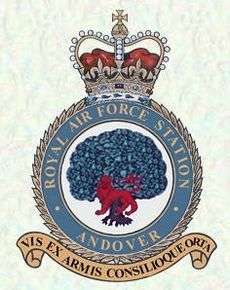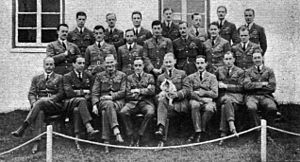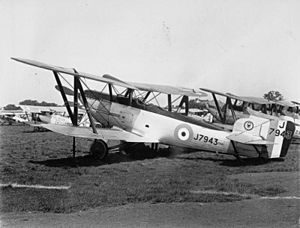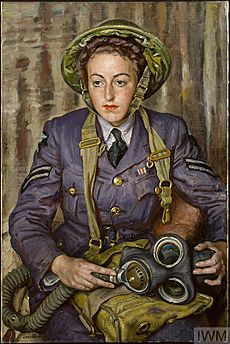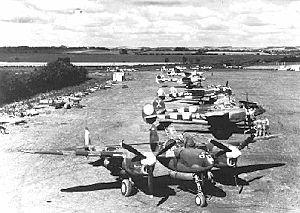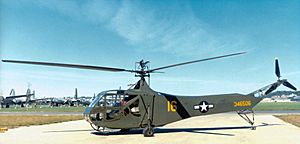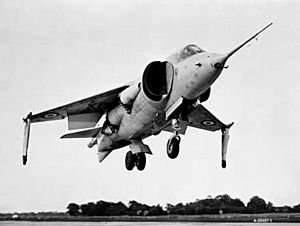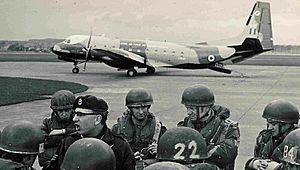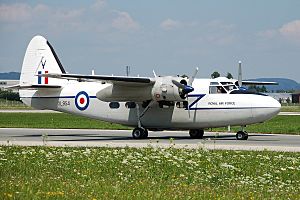RAF Andover facts for kids
Quick facts for kids RAF AndoverUSAAF Station 406 |
|||||||
|---|---|---|---|---|---|---|---|
| Andover, Hampshire in England | |||||||

Aerial photograph of RAF Andover oriented north, 16 January 1947
|
|||||||
|
Shown within Hampshire
|
|||||||
| Coordinates | 51°12′31″N 001°31′31″W / 51.20861°N 1.52528°W | ||||||
| Type | Royal Air Force station | ||||||
| Site information | |||||||
| Owner | Ministry of Defence | ||||||
| Operator | Royal Air Force United States Army Air Forces 1944 |
||||||
| Controlled by | RAF Fighter Command 1939-40 RAF Army Cooperation Command 1940-44 |
||||||
| Site history | |||||||
| Built | 1917 | ||||||
| In use | August 1917-1977 | ||||||
| Battles/wars | First World War European theatre of World War II Cold War |
||||||
| Airfield information | |||||||
| Identifiers | IATA: ADV, ICAO: EGWA | ||||||
| Elevation | 79 metres (259 ft) AMSL | ||||||
|
|||||||
RAF Andover was a very important air base in England. It was located about 2 miles west of Andover, Hampshire. This base was used by the Royal Flying Corps and the Royal Air Force. Other air forces also used it, including those from the United States and Canada.
This airfield is famous for a few reasons. During the First World War, it was the site of the first attempt to create a long-range electronic navigation system. This system helped guide planes. Later, during the Second World War, it became home to the first British military helicopter unit. It also had the first helicopter flying school in Europe.
RAF Andover was also used for testing new aircraft and for aviation research. In 1922, the RAF Staff College, Andover was started here. This was the first college to train officers on how to manage and lead an air force.
During the Second World War, RAF Andover saw real action. A brave woman named Corporal Josephine Robins, who was part of the WAAF, won a special medal for rescuing people during an air raid. Three Canadian air force squadrons were also formed at RAF Andover. Before and during the Battle of Normandy, the United States Army Air Forces used it as a base for their fighter planes.
The RAF base closed in 1977. The land was later redeveloped. In 2009, a part of it became Marlborough Lines. This is now the main home for the British Army Headquarters.
The History of Andover Airfield
Early Days: Before 1912
People have lived and worked on the land where Andover Airfield was built for a very long time. We know this from archaeological findings. These findings show that people lived here in the Bronze Age and Iron Age. There were also Anglo-Saxon and medieval burial sites.
Military activity started around 43 AD. This is when the Portway, a Roman road, was built. This road connected Silchester to Old Sarum. Another Roman road, the Icknield Way, met the Portway near the airfield.
In 1910, a British Army airship called Beta had to make an emergency landing very close to where the airfield would later be.
First World War: 1912 to 1918
The Royal Flying Corps (RFC) opened an air base near Andover in August 1917. This was during the First World War. German prisoners of war helped build most of the base. Some of them even left their names written in the buildings.
The base's motto meant "With determination and equipment, I take counsel to rise up." This showed its purpose: to train aircrews. These crews learned to fly large bombers like the Handley Page Type O and the Airco DH.9. The first group to arrive was the No. 2 School of Navigation and Bomb Dropping. They moved in while the base was still being built.
One of the squadrons formed at Andover was 106 Squadron. They started on September 30, 1917. They used Royal Aircraft Factory R.E.8 planes for scouting and helping the army. They moved to Ireland in May 1918.
American squadrons also used the airfield. From December 1917 to June 1918, parts of the 13th Aero Squadron and 104th Aero Squadron were based here.
In early 1918, important experiments happened at Andover. Handley Page Type O bombers were fitted with Radio Direction-Finding (RDF) equipment. This was to help them fly at night. The goal was to guide British bombers to and from Berlin. This was the first time anyone tried to create a long-range electronic navigation system. Today, similar systems are used all over the world.
When RAF Andover closed in 1977, many old items from the airfield were given to the 1213 (Andover) Squadron Air Training Corps. These included a large wooden copy of the RFC cap badge. This badge is now on display at the Army Flying Museum.
Between the Wars: 1918 to 1939
Between the two World Wars, RAF Andover was home to several RAF units. In 1919, the No. 2 School of Navigation and Bomb Dropping became the RAF School of Navigation. The RAF Staff College was started here on April 1, 1922. It trained officers to become leaders. The college later moved to Bracknell in 1970.
You can still find a reminder of the RAF Staff College at the old airfield. It's a headstone from 1926 for a dog named Jane. She belonged to the first leader of the college, Robert Brooke-Popham.
The idea for the Royal Air Forces Association, a group for RAF members, came from a conversation at RAF Andover in 1929.
RAF Andover continued to be used for testing new aircraft. Several experimental military planes made their first flights from here. These included the Westland Yeovil, the Westland Witch, the Westland F.7/30, and all the Westland-Hill Pterodactyl experimental flying wing aircraft.
Two special bomber squadrons, No. 12 Squadron RAF and No. 101 Squadron RAF, were based at Andover in the late 1920s and early 1930s. No. 13 Squadron was also here for five years, flying Armstrong Whitworth Atlas planes.
No. 12 Squadron flew Fairey Fawn bombers from 1924. Later, they used the Fairey Fox bomber, which was much faster than other planes of its time. Even today, 12 Squadron's motto, 'Leads the Field', and its fox emblem remember their time at RAF Andover. The Fairey Fox was the first all-metal aircraft used in service.
In 1928, during a big air defense exercise, 12 Squadron was asked to pretend to bomb London. To celebrate their success, the Royal Air Force leader chose a fox's face as the squadron's symbol.
The squadron's training included bombing, flying in formation, navigation, and gunnery. They also tested parachutes for aircrew. Observers would jump from the plane at 2,000 feet over the airfield. They also tested oxygen systems and high-altitude photography.

In 1931, the Foxes were replaced by the Hawker Hart. The squadron then focused on flying in clouds, using instruments, and bombing in patterns. They wanted to be able to bomb enemy ships in any weather. They even dropped practice bombs on an old battleship, HMS Centurion, off the coast. On July 6, 1935, King George V reviewed the Royal Air Force for the first time. 12(B) Squadron led the bomber planes in a flypast at RAF Mildenhall.
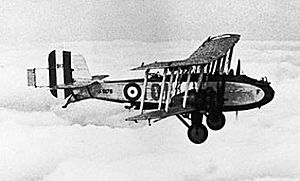
In October 1935, several squadrons, including 12 Squadron, were sent to the Middle East. This was because the League of Nations was considering action against Italy for invading Abyssinia. 12 Squadron returned to Andover in August 1936 and received new Hawker Hind planes. In 1936, 12 Squadron hosted a visit from German Minister of War, Generalfeldmarschall Werner von Blomberg. In February 1938, the squadron got Fairey Battle planes and left RAF Andover in May 1939.
In October 1929, No. 101 Squadron also came to RAF Andover. They flew Boulton-Paul Sidestrand bombers. These planes were very impressive and performed mock combat flights at air shows. 101 Squadron won many bombing and scouting contests. They also practiced attacking Royal Navy battleships. The squadron left Andover in December 1934.
Second World War: 1939 to 1945
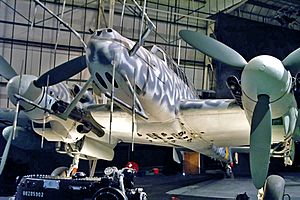
During the Second World War, RAF Andover was the main base for RAF Maintenance Command. It was also used for training pilots and as a fighter base by the United States Army Air Forces (USAAF). From 1937, Andover had a special code, AV. This code was broadcast by a mobile red light beacon at night. It was also painted on the hangar closest to the control tower. This code remained visible until the hangars were taken down in 2001.
When Andover was a USAAF base, it was known as Station 406.
The Air Transport Auxiliary's (ATA) Central Ferry Control was also based at RAF Andover. The ATA was a civilian group that had female pilots, which was unusual at the time. They moved military aircraft between factories, repair shops, and active airfields. Central Ferry Control decided which flights each ATA group would do.
RAF Andover was one of four airfields in Hampshire that had a decoy site in 1940. These sites were designed to trick enemy planes into bombing a fake target. Andover's decoy site was at Hurstbourne Tarrant. It had fake aircraft and buildings. Later, fake machine gun posts were added there.
The German air force, the Luftwaffe, attacked RAF Andover twice during the Battle of Britain. On August 13, 1940, about 12 bombs were dropped by German Junkers Ju 88 planes. The base headquarters and officers' living areas were badly damaged. One plane on the base was also damaged. Two people were killed. The next day, August 14, 1940, Andover was attacked again. About 15 bombs were dropped, destroying a radio set and killing a civilian radio operator.
Corporal Josephine Robins, a telephone operator with the Women's Auxiliary Air Force (WAAF) at RAF Andover, was given the Military Medal for her bravery during these raids. Her award citation said she was in a shelter that was directly hit. Many men were killed, and two were badly hurt. Even though there was dust and smoke, Corporal Robins immediately helped the wounded. She got a stretcher and stayed with them until they were moved. She showed great courage in a very dangerous situation. Corporal Robins was one of only six WAAF members to receive this medal during the entire Second World War.
At the time, people thought these raids were aimed at the important 11 Group Fighter Command base at RAF Middle Wallop. However, German records show that RAF Andover was the real target. The Luftwaffe mistakenly believed it was an active bomber base. In 1941, RAF Andover was attacked twice more. One hangar was so badly damaged that it had to be taken down.
In June 1941, the No. 2 School of Army Co-operation at Andover became No. 6 Operational Training Unit (OTU). They used Bristol Blenheim planes. Their job was to train pilots to fly Bristol Blenheim Mk. Vs for ground attacks. These pilots would then serve in the Middle East and Far East. No. 6 OTU later moved to RAF Ashbourne in October 1942.
From February to July 1944, Andover was used by fighter squadrons of the 71st Fighter Wing of the Ninth Air Force of the United States Army Air Forces. They flew Lockheed P-38 Lightning aircraft. From RAF Andover, these planes bombed radar stations and anti-aircraft towers. They also protected bombers that attacked bridges and railway yards in France. This was all part of the preparations for the invasion of Europe. The planes also provided cover for Allied forces crossing the English Channel on D-Day. They flew scouting missions over the Cotentin Peninsula until the end of the month. The 370th Fighter Group then moved to France on July 20. The USAAF lost 31 P-38s from Andover before moving to France.
Three Canadian Army Air Observation Post (AOP) Squadrons of the Royal Canadian Air Force were formed at RAF Andover. These were No. 664 Squadron RCAF, No. 665 Squadron RCAF, and No. 666 Squadron RCAF. They were formed between December 1944 and March 1945. They used Auster Mark IV and V aircraft. The pilots and observers were officers from the Royal Canadian Artillery.
Pilots were trained at No. 43 Operational Training Unit at RAF Andover. This unit focused on training British and Commonwealth AOP flight crews. One famous Canadian student trained here was Captain James Doohan. He later became famous as the actor who played Chief Engineer Lieutenant Commander Scott in Star Trek. While training, he even flew an Auster Mark IV between two telegraph poles to prove it could be done!
British Army AOP training with Auster Mark V aircraft continued at RAF Andover until at least 1949.
RAF Andover holds a special place in British history. The first British military unit to use helicopters was formed here in January 1945. It was called the Helicopter Training Flight. This was also the first European helicopter flying school. The flight used nine Sikorsky R-4B Hoverfly I helicopters. It trained 100 British Army pilots for AOP duties. It also trained pilots for the first RAF squadron to use helicopters, 529 Squadron.
After the War: 1945 to 1977
After the war, RAF Andover continued to be used for helicopter training and research. In February 1947, a unit called 1901 (Air Observation Post) Flight was formed. They used six Sikorsky R-6A Hoverfly 2 helicopters and Auster AOP.6 planes. They trained British Army and Royal Air Force pilots. They also did experiments with helicopters, like photography and radar trials. In January 1948, the Flight moved to Middle Wallop.
On September 14, 1955, RAF Andover was given the freedom of the Borough of Andover. This was a special honor. No. 12 Squadron RAF took part in the ceremony. Their English Electric Canberra B Mk. 6 bombers flew over to celebrate their past connection with RAF Andover.
Andover continued its role in helicopter development. The Joint Experimental Helicopter Unit was based here from 1958 to 1959. This unit, made up of members from the Royal Navy, Army, and RAF, explored how helicopters could be used in operations. They used Westland Whirlwind helicopters.
The base also continued its aviation research. Tests for the Hawker P.1127, the Hawker Siddeley Kestrel FGA 1 (both experimental vertical take-off planes), and the Hawker Siddeley Harrier took place here. The Harrier was a developed version of these planes. It was the world's first operational vertical/short take-off and landing aircraft.
Tests for the Hawker Siddeley Andover aircraft also happened at RAF Andover. This plane was even named after the town! The Andover's main job was to transport things. It could "kneel" down, allowing vehicles to drive up a ramp into its back. It was also used for medical evacuations, short take-offs and landings, and dropping parachutes or containers. Andovers were used by the RAF until 2012.
Throughout the period after 1945, RAF Andover was home to several communication squadrons. The last one was No. 21 Squadron RAF. They used de Havilland Devon and Percival Pembroke aircraft. This squadron provided transport for senior officers in the western UK. It was disbanded in 1976 due to defense cuts.
Just before the RAF base closed in 1977, the 1213 (Andover) Squadron Air Training Corps moved into the building that used to be the Station Headquarters.
After the RAF: Post-1977 Use
The RAF base closed on June 10, 1977. The airfield was then given to the British Army. It was used by Army Air Corps units from Middle Wallop. The last RAF staff working here left in November 2009. The former airfield still has an RAF connection through the 1213 (Andover) Squadron, Air Training Corps. A former cadet from this squadron, Lieutenant-Commander Gordon Batt, was killed in action during the Falklands War in 1982.
RAF Andover's Legacy
Andover Road in Singapore is named after RAF Andover. This is because of the former RAF Changi base there.
The RAF Museum has several aircraft that were once based at RAF Andover. These include a Sikorsky R-4B Hoverfly I, an Avro Anson C. 19, a De Havilland Dove C. 1, and a Percival Pembroke C. 2. They also have two German planes captured in 1944: a Junkers Ju 87 G-2 dive bomber and a Messerschmitt Bf 110 G-4 night fighter. The National Museum of Flight in Scotland has RAF Andover's former gate guardian, a Supermarine Spitfire LF Mk. XVIE.
Redevelopment of the Site
When the A303 main road was straightened, its new path crossed the northern edge of the old airfield. In 2013, a solar farm was built on the rest of the site, south of the A303.
In 2007, there was a local debate about building a very large distribution center for the Tesco supermarket company on the airfield site. The main building would have been huge, over 85,000 square meters (21 acres). This would have made it one of the biggest buildings in Europe. The plan was approved in 2008, but the deal with Tesco didn't happen. Instead, a distribution center for the Co-op Group was built, and the rest of the site became a business park.
To mark the airfield's closure, a sculpture called "Flight and Navigation" was revealed on October 6, 2014. It shows aircraft that flew from the airfield. The last RAF flag to fly from the airfield was also displayed. A local councilor, Ian Carr, who used to be a navigator with No. 21 Squadron RAF at the airfield, had kept the flag.
Marlborough Lines: A New Chapter
Starting in November 2009, a part of the old airfield was named Marlborough Lines. This area then became the new home for the Headquarters of the British Army.
Images for kids




